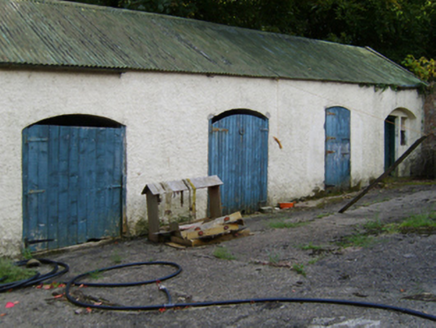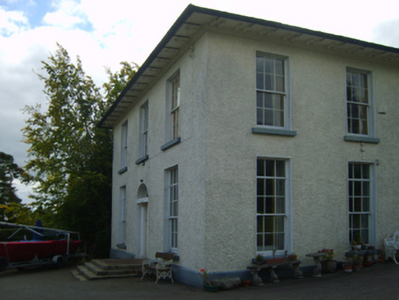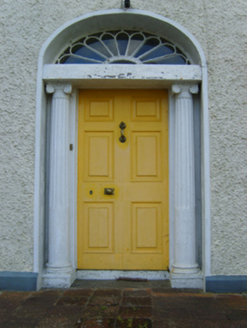Survey Data
Reg No
15703739
Rating
Regional
Categories of Special Interest
Architectural, Artistic, Historical, Social
Original Use
Farm house
In Use As
Farm house
Date
1815 - 1825
Coordinates
300355, 121674
Date Recorded
29/08/2007
Date Updated
--/--/--
Description
Detached three-bay two-storey farmhouse, built 1820, on an L-shaped plan with three-bay (east) or two-bay (west) two-storey side elevations. Hipped slate roof on an L-shaped plan with pressed iron ridges, paired rendered central chimney stacks having cut-granite stringcourses below capping, and replacement uPVC rainwater goods on overhanging eaves having paired timber consoles retaining cast-iron downpipes. Part creeper- or ivy-covered roughcast walls on rendered chamfered plinth; part slate hung surface finish to rear (south) elevation. Segmental-headed central door opening approached by flight of four cut-granite steps, doorcase with three quarter-engaged fluted Ionic columns supporting monolithic cornice, and concealed dressings framing timber panelled door having fanlight. Square-headed window openings (ground floor) with cut-granite sills, and concealed dressings framing six-over-six timber sash windows having overlights. Square-headed window openings (first floor) with cut-granite sills, and concealed dressings framing six-over-six timber sash windows. Interior including (ground floor): central hall retaining carved timber surrounds to door openings framing timber panelled doors; and carved timber surrounds to door openings to remainder framing timber panelled doors with carved timber surrounds to window openings framing timber panelled shutters on panelled risers. Set in landscaped grounds.
Appraisal
A farmhouse representing an integral component of the early nineteenth-century domestic built heritage of County Wexford with the architectural value of the composition, one recalling the contemporary Curracloe House (1831; see 15703806), suggested by such attributes as the deliberate alignment maximising on scenic vistas overlooking gently rolling grounds with '[an] adjoining ancient and hoary castle' as a picturesque eye-catcher in the near distance (Lacy 1863, 465); the compact plan form centred on a Classically-detailed doorcase showing a simplified "peacock tail" fanlight; the diminishing in scale of the openings on each floor producing a graduated visual impression with the principal "apartments" or reception rooms defined by so-called "Wexford Window" sash-and-overlight glazing pattens; and the decorative timber work embellishing a slightly oversailing roofline. Having been well maintained, the elementary form and massing survive intact together with substantial quantities of the original fabric, both to the exterior and to the interior, including a partial slate hung surface finish widely regarded as an increasingly endangered hallmark of the architectural heritage of County Wexford: meanwhile, contemporary joinery; chimneypieces; and plasterwork refinements, all highlight the artistic potential of the composition. Furthermore, adjacent outbuildings (extant 1840) continue to contribute positively to the group and setting values of a self-contained ensemble having historic connections with Sheppard Jeffares (1774-1859), Mayor of Wexford (fl. 1840; 1846-7) 'late of Barntown in the County of Wexford' (Calendars of Wills and Administrations 1859, 137).





